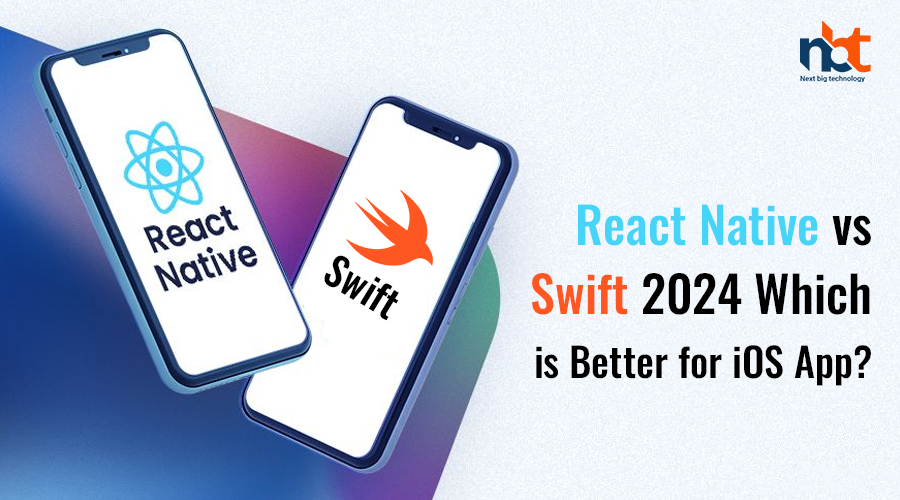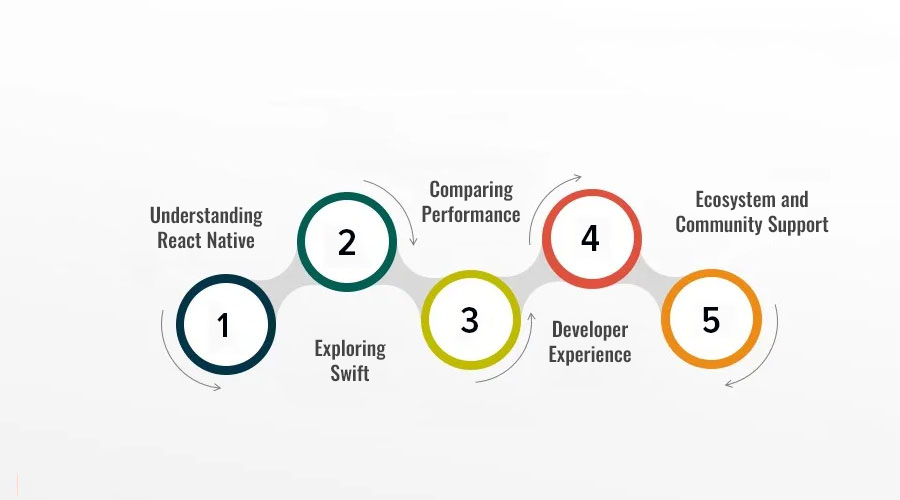Table of Contents
Introduction to React Native and Swift
In today’s fast-paced digital landscape, mobile applications have become an integral part of our daily lives. Whether it’s ordering food, booking a ride, or staying connected with loved ones, the demand for intuitive and responsive mobile apps continues to soar. To meet this demand, developers are constantly seeking efficient ways to build high-quality applications that run seamlessly across different platforms.
Two popular technologies that have gained significant traction in the realm of mobile app development are React Native and Swift. In this article, we’ll take a closer look at these frameworks and explore their capabilities, advantages, and how they empower developers to create innovative cross-platform applications.
Understanding React Native: React Native is an open-source framework developed by Facebook that allows developers to build mobile applications using JavaScript and React. What sets React Native apart is its ability to leverage a single codebase to develop apps for both iOS and Android platforms, significantly reducing development time and effort.
One of the key advantages of React Native is its component-based architecture, which enables developers to build reusable UI components. This not only streamlines the development process but also ensures consistency and scalability across different parts of the application.
Moreover, React Native provides access to a vast ecosystem of third-party libraries and plugins, allowing developers to integrate advanced features and functionalities seamlessly. Additionally, React Native offers hot reloading, which enables developers to see the changes in real-time as they code, making the development process more efficient and productive.
Exploring Swift: On the other hand, Swift is a powerful and intuitive programming language developed by Apple for building applications for iOS, macOS, watchOS, and tvOS. Introduced in 2014, Swift was designed to be fast, safe, and expressive, making it an ideal choice for developing high-performance iOS applications.
Swift comes with a modern syntax that is easy to read and write, making it accessible to both new and experienced developers. Its strong type system and memory management features help developers write safer and more reliable code, reducing the likelihood of bugs and crashes.
Furthermore, Swift offers interoperability with Objective-C, allowing developers to leverage existing Objective-C code and libraries seamlessly. This makes the transition to Swift smoother for developers who are already familiar with Objective-C or working on projects that require interoperability between the two languages.
Bridging the Gap: While React Native and Swift are primarily used for developing applications for different platforms, there are scenarios where developers may need to combine both technologies to achieve their goals. For instance, developers may use React Native to build the core logic and UI components of their application and then utilize Swift to access platform-specific APIs or implement performance-critical features.
By bridging React Native and Swift, developers can leverage the strengths of both frameworks to create robust, feature-rich applications that deliver a seamless user experience across iOS and Android platforms.
Development Ecosystem and Community Support
In the realm of technology and innovation, the development ecosystem and community support form the bedrock upon which groundbreaking ideas thrive and flourish. This dynamic interplay between creators, innovators, and supporters creates a fertile ground for progress, fostering collaboration, and driving advancements across various sectors.
Understanding the Development Ecosystem: The development ecosystem encompasses a diverse array of components, including software platforms, tools, frameworks, and libraries. These elements collectively provide developers with the necessary resources to conceptualize, build, and deploy their projects efficiently. From programming languages like Python and JavaScript to robust frameworks such as React and Django, each component plays a crucial role in streamlining the development process and enhancing productivity.
Moreover, cloud computing services, such as Amazon Web Services (AWS) and Microsoft Azure, offer scalable infrastructure and powerful tools that empower developers to leverage the full potential of their applications. The emergence of DevOps practices further bridges the gap between development and operations, promoting seamless collaboration and continuous integration/continuous deployment (CI/CD) pipelines.
The Significance of Community Support: Community support stands as a cornerstone of the development ecosystem, fostering a sense of belonging, collaboration, and knowledge sharing among developers worldwide. Online forums, discussion boards, and social media platforms serve as vibrant hubs where developers exchange ideas, seek assistance, and celebrate successes. These communities not only provide invaluable technical insights but also nurture a culture of inclusivity and mentorship.
Open-source initiatives play a pivotal role in driving innovation and democratizing access to cutting-edge technologies. Projects like Linux, Apache, and Kubernetes exemplify the power of collaborative development, where contributors from diverse backgrounds collaborate to build robust, scalable solutions that benefit the entire community.
Fueling Innovation Through Collaboration: Collaboration lies at the heart of the development ecosystem, fueling innovation and propelling progress forward. Hackathons, meetups, and conferences serve as catalysts for creativity, bringing together developers, designers, and entrepreneurs to brainstorm ideas and tackle real-world challenges. These collaborative endeavors not only foster interdisciplinary cooperation but also cultivate a culture of experimentation and risk-taking.
Furthermore, mentorship programs and educational initiatives play a crucial role in nurturing the next generation of developers. By providing aspiring technologists with guidance, resources, and hands-on experience, these programs empower individuals to embark on their journey towards mastery and proficiency.
User Interface (UI) Development Capabilities
In today’s digital age, where user experience reigns supreme, the significance of User Interface (UI) development cannot be overstated. UI development encompasses the creation of visually appealing and functionally intuitive interfaces that facilitate seamless interactions between users and digital products or services. With technology advancing at a rapid pace, the capabilities of UI development have undergone a transformative evolution, empowering developers to craft immersive and engaging user experiences like never before.
Responsive Design for Multi-Device Compatibility: One of the primary objectives of modern UI development is to ensure compatibility across a myriad of devices, ranging from traditional desktop computers to smartphones, tablets, and wearable gadgets. Responsive design techniques enable UI developers to create interfaces that dynamically adjust and adapt to various screen sizes and resolutions, providing users with a consistent and optimized experience across different devices.
Rich and Interactive Visual Elements: Gone are the days of static web pages dominated by plain text and simple graphics. Today’s UI development landscape offers a plethora of tools and technologies for integrating rich and interactive visual elements into user interfaces. From animated transitions and micro-interactions to immersive multimedia content, developers have the means to captivate users and elevate the overall user experience to new heights.
Accessibility and Inclusive Design: Inclusivity is a core principle driving contemporary UI development practices. Developers strive to create interfaces that are accessible to users of all abilities, ensuring that individuals with disabilities can navigate and interact with digital products seamlessly. By adhering to accessibility guidelines and implementing features such as screen readers, keyboard navigation support, and color contrast adjustments, UI developers can make their creations more inclusive and user-friendly.
Cross-Platform Compatibility and Integration: With the proliferation of diverse operating systems and platforms, UI developers face the challenge of ensuring cross-platform compatibility and seamless integration across different environments. Frameworks like React Native, Flutter, and Xamarin empower developers to build native-quality interfaces for multiple platforms using a single codebase, streamlining the development process and enhancing efficiency.
Data-Driven Decision Making with Analytics: In the realm of UI development, data plays a pivotal role in informing design decisions and optimizing user experiences. Advanced analytics tools enable developers to gather insights into user behavior, preferences, and interactions, allowing them to fine-tune interfaces for maximum effectiveness. By leveraging data-driven methodologies, UI developers can iterate rapidly, identify pain points, and refine their designs to better meet user needs and expectations.
Augmented Reality (AR) and Virtual Reality (VR) Experiences: The advent of augmented reality (AR) and virtual reality (VR) technologies has opened up exciting new possibilities for UI development. From immersive gaming experiences to interactive training simulations and virtual product showcases, UI developers are leveraging AR and VR to create truly immersive and engaging user interfaces that blur the lines between the physical and digital worlds.
Access to Native Features and APIs
In the dynamic landscape of technology, access to native features and APIs plays a pivotal role in shaping the user experience and functionality of applications across various platforms. From mobile apps to web browsers, harnessing the power of native features and APIs empowers developers to create seamless and innovative experiences for users.
Native features refer to the built-in functionalities and capabilities of a specific platform or device. These features are often optimized for performance and integration, allowing developers to leverage them to enhance their applications. Whether it’s accessing the camera, microphone, GPS, or sensors, tapping into native features enables developers to create immersive experiences that resonate with users.
On the other hand, Application Programming Interfaces (APIs) serve as intermediaries that allow different software applications to communicate and interact with each other. APIs provide developers with access to a wealth of resources and services, enabling them to extend the functionality of their applications beyond their core capabilities. By integrating with APIs, developers can leverage external services such as payment gateways, social media platforms, and data analytics tools, enriching their applications with additional functionalities.
The combination of native features and APIs opens up a world of possibilities for developers to create innovative and feature-rich applications. Let’s explore some key benefits of leveraging native features and APIs:
- Enhanced User Experience: By tapping into native features such as gestures, notifications, and accessibility services, developers can create intuitive and user-friendly interfaces that resonate with their target audience. Integrating with APIs allows developers to access additional services and content, enriching the user experience and keeping users engaged.
- Improved Performance: Native features are often optimized for performance and efficiency, allowing applications to run smoothly and respond quickly to user interactions. By leveraging native features, developers can ensure that their applications deliver a seamless and responsive experience across different devices and platforms.
- Access to Device Capabilities: Native features provide direct access to the underlying hardware and software capabilities of a device, enabling developers to create applications that make full use of the device’s potential. Whether it’s capturing high-quality photos with the camera, tracking location with GPS, or utilizing motion sensors for gaming, native features allow developers to unlock new possibilities and functionalities.
- Seamless Integration: APIs enable seamless integration with third-party services and platforms, allowing developers to incorporate additional functionalities into their applications with ease. Whether it’s integrating with social media platforms for sharing content, incorporating payment gateways for in-app purchases, or accessing machine learning algorithms for data analysis, APIs provide developers with the tools they need to extend the capabilities of their applications.
- Scalability and Flexibility: By leveraging native features and APIs, developers can create scalable and flexible applications that can adapt to evolving user needs and technological advancements. Whether it’s adding new features, integrating with emerging technologies, or expanding to new platforms, native features and APIs provide developers with the flexibility they need to stay ahead of the curve.
Codebase Maintenance and Scalability
In the fast-paced world of software development, maintaining a healthy codebase is crucial for the long-term success of any project. As applications grow in complexity and user base, scalability becomes equally important. This article explores the significance of codebase maintenance and scalability, along with strategies to ensure they are effectively managed.
Understanding Codebase Maintenance:
Codebase maintenance involves the continuous process of managing, updating, and enhancing the code that powers an application. It encompasses tasks such as fixing bugs, optimizing performance, adding new features, and refactoring code for better readability and maintainability. Neglecting codebase maintenance can lead to technical debt, where the cost of future development increases due to accumulated issues and inefficiencies.
Challenges in Codebase Maintenance:
Several challenges arise when maintaining a codebase, including:
- Legacy Code: Older sections of code that are no longer actively maintained can become a burden, making it harder to introduce changes or fix bugs.
- Dependencies: Managing dependencies, including third-party libraries and frameworks, requires careful attention to compatibility issues and security vulnerabilities.
- Documentation: Inadequate or outdated documentation can hinder the understanding of the codebase, leading to confusion and inefficiency for developers.
- Testing: Ensuring comprehensive test coverage is essential to catch regressions and validate changes without introducing new bugs.
Strategies for Effective Codebase Maintenance:
- Regular Code Reviews: Conducting regular code reviews helps identify potential issues early and promotes knowledge sharing among team members.
- Automated Testing: Implementing automated testing frameworks, including unit tests, integration tests, and end-to-end tests, helps maintain code quality and prevents regressions.
- Continuous Integration and Deployment (CI/CD): Setting up CI/CD pipelines automates the process of building, testing, and deploying code changes, reducing the risk of human error and accelerating the release cycle.
- Refactoring: Periodically refactoring code improves its maintainability and scalability by eliminating redundancy, improving performance, and adhering to coding best practices.
Scalability:
Scalability refers to the ability of a system to handle increasing workload and adapt to growing demands without sacrificing performance or reliability. Achieving scalability requires careful design and architecture decisions that anticipate future growth and allow for seamless expansion.
Key Considerations for Scalability:
- Horizontal vs. Vertical Scaling: Horizontal scaling involves adding more instances of resources, such as servers, to distribute the workload, while vertical scaling involves upgrading existing resources to handle increased demand.
- Decoupling Components: Decoupling components within the application architecture allows for independent scaling of different parts of the system, enabling better resource utilization and flexibility.
- Caching: Implementing caching mechanisms, both at the application and database levels, can significantly improve performance by reducing the need to repeatedly fetch data from disk or external sources.
- Asynchronous Processing: Leveraging asynchronous processing techniques, such as message queues and event-driven architectures, helps offload heavy processing tasks and improves system responsiveness.
Learning Curve and Developer Productivity
In the dynamic realm of software development, the learning curve is both a challenge and an opportunity. As developers delve into new technologies, languages, or frameworks, they encounter a spectrum of obstacles and triumphs that shape their journey towards mastery. Understanding this learning curve and its correlation with developer productivity is crucial for teams and individuals striving for success in the ever-evolving tech landscape.
Embracing the Learning Curve
The learning curve symbolizes the progression from initial confusion and incompetence to proficiency and expertise. For developers, it begins with the excitement of exploration and the daunting prospect of grappling with unfamiliar concepts. As they navigate through documentation, tutorials, and hands-on experimentation, they gradually ascend the curve, acquiring knowledge and honing their skills.
Challenges Along the Way
However, the learning curve is not without its challenges. Developers may encounter frustration, setbacks, and moments of self-doubt. The sheer volume of information to absorb can be overwhelming, leading to feelings of imposter syndrome or burnout. Moreover, technological advancements mean that the curve is constantly shifting, requiring continuous adaptation and learning.
Impact on Productivity
Despite these challenges, mastering the learning curve is essential for enhancing developer productivity. As developers gain proficiency in new technologies, they become more adept at problem-solving, writing efficient code, and collaborating with team members. Additionally, learning fosters creativity and innovation, enabling developers to devise novel solutions to complex problems.
Strategies for Success
To maximize productivity amidst the learning curve, developers can employ several strategies:
- Break It Down: Rather than attempting to learn everything at once, break the learning process into manageable chunks. Focus on mastering one concept or skill before moving on to the next.
- Practice Regularly: Consistent practice is key to reinforcing learning and building fluency. Allocate dedicated time for coding exercises, side projects, or participation in coding challenges.
- Seek Feedback: Solicit feedback from peers, mentors, or online communities to gain insights into areas for improvement. Embrace constructive criticism as a means of refining your skills.
- Stay Curious: Cultivate a curious mindset and a willingness to explore new technologies and approaches. Stay updated on industry trends and best practices to remain relevant in a rapidly evolving field.
- Embrace Failure: Understand that failure is an integral part of the learning process. Instead of being discouraged by setbacks, view them as opportunities for growth and learning.
App Store Approval Process and Guidelines Compliance
In today’s digital landscape, where mobile apps reign supreme, getting your app approved on the Apple App Store can be the make-or-break moment for its success. With millions of apps vying for attention, ensuring your app meets Apple’s stringent guidelines is essential. In this guide, we’ll delve into the intricacies of the App Store approval process and how to ensure compliance every step of the way.
Understanding the App Store Review Guidelines
Before diving into the submission process, it’s crucial to familiarize yourself with the App Store Review Guidelines. These guidelines outline Apple’s requirements for apps to be accepted onto their platform. Covering everything from design and functionality to legal and safety considerations, these guidelines serve as the roadmap for developers.
Preparing Your App for Submission
Once you’re well-versed in the guidelines, the next step is preparing your app for submission. This involves thorough testing to ensure it functions seamlessly across all devices and meets Apple’s quality standards. Pay close attention to factors such as user interface design, performance, and compatibility with the latest iOS versions.
App Store Connect: The Submission Process
With your app polished and ready to go, it’s time to navigate the App Store Connect platform for submission. This is where you’ll provide all the necessary information about your app, including its description, screenshots, and metadata. Be sure to accurately represent your app and avoid misleading users, as transparency is key to gaining Apple’s approval.
App Review Process
Once you’ve submitted your app, it enters the review queue, where Apple’s team of experts meticulously assesses it against the App Store Review Guidelines. This process typically takes anywhere from a few days to a couple of weeks, depending on the volume of submissions.
During the review process, it’s essential to remain responsive to any inquiries or requests from the review team. Addressing any issues promptly can expedite the approval process and ensure a smoother experience overall.
Common Pitfalls to Avoid
While striving for compliance, it’s easy to overlook certain aspects that could result in rejection. Some common pitfalls to avoid include:
- Incomplete or Inaccurate Information: Ensure all information provided during submission is accurate and up-to-date.
- Broken Functionality: Thoroughly test your app to identify and fix any bugs or glitches that could hinder user experience.
- Violations of App Store Guidelines: Familiarize yourself with the guidelines and ensure your app adheres to them in all aspects.
Cross-Platform Compatibility and Code Reusability
In today’s fast-paced digital landscape, developers face the challenge of creating software that functions seamlessly across various platforms. From desktop computers to mobile devices, and everything in between, ensuring cross-platform compatibility has become paramount. However, achieving this goal can be complex and time-consuming without the right strategies in place. This is where the concept of code reusability comes into play, offering a solution that not only saves time and resources but also enhances the overall efficiency of development processes.
Cross-platform compatibility refers to the ability of software or applications to run smoothly on different operating systems or devices. With the multitude of platforms available today, including Windows, macOS, iOS, Android, and Linux, developers must adopt approaches that allow their products to reach a broader audience without sacrificing quality or performance. This entails designing and implementing code that can adapt to the unique requirements and constraints of each platform, while still maintaining consistency and functionality across the board.
One of the most effective strategies for achieving cross-platform compatibility is through the use of cross-platform development frameworks and tools. These frameworks, such as Xamarin, React Native, and Flutter, enable developers to write code once and deploy it across multiple platforms, significantly reducing development time and effort. By leveraging a single codebase, developers can streamline the development process, minimize potential errors, and ensure a consistent user experience across all platforms.
Furthermore, code reusability plays a crucial role in enhancing cross-platform compatibility. By modularizing and structuring code in a way that promotes reuse, developers can avoid duplication of effort and maximize efficiency. Components, libraries, and modules can be developed and reused across different projects or platforms, saving valuable time and resources in the long run. Additionally, code reusability fosters consistency and maintainability, as updates or modifications can be applied uniformly across all instances where the code is used.
Another benefit of code reusability is its impact on software maintenance and scalability. As applications evolve and grow over time, having a robust foundation of reusable code makes it easier to implement changes, add new features, or expand functionality without starting from scratch. This not only reduces the risk of introducing bugs or errors but also ensures that development efforts remain focused on innovation rather than repetitive tasks.
Integration with Third-Party Libraries and Services
In today’s digital landscape, the ability to seamlessly integrate third-party libraries and services into your applications is paramount for staying competitive and delivering high-quality user experiences. Whether you’re developing a mobile app, a web application, or enterprise software, leveraging the functionalities provided by external libraries and services can significantly enhance your product’s capabilities and efficiency.
Understanding Third-Party Integration:
Third-party libraries and services encompass a wide range of tools and functionalities, including but not limited to:
- APIs (Application Programming Interfaces): APIs allow applications to communicate and interact with external services, enabling data exchange and functionality extension.
- Software Development Kits (SDKs): SDKs provide pre-built components, tools, and resources for developers to integrate specific functionalities or services into their applications seamlessly.
- Frameworks and Plugins: Frameworks and plugins offer ready-made solutions for common development tasks or functionalities, saving developers time and effort.
Benefits of Integration:
Integrating third-party libraries and services offers numerous benefits, including:
- Faster Development: Leveraging pre-built functionalities reduces development time and effort, allowing developers to focus on core features and business logic.
- Enhanced Functionality: Third-party libraries and services often provide specialized functionalities or features that may not be feasible or practical to develop in-house.
- Cost-Effectiveness: Integrating existing solutions eliminates the need for building everything from scratch, saving both time and resources.
- Scalability and Flexibility: Third-party solutions are often designed to scale with your application’s growth and adapt to changing requirements, providing flexibility and future-proofing.
Best Practices for Integration:
To ensure successful integration with third-party libraries and services, consider the following best practices:
- Thorough Research: Before integrating any third-party solution, conduct thorough research to assess its suitability, reliability, and compatibility with your application’s architecture and requirements.
- Documentation Review: Review the documentation provided by the third-party provider to understand the integration process, API endpoints, authentication mechanisms, and usage guidelines.
- Error Handling and Monitoring: Implement robust error handling mechanisms to gracefully handle exceptions and errors that may arise during integration. Additionally, set up monitoring tools to track API usage, performance metrics, and potential issues.
- Security Considerations: Prioritize security when integrating third-party libraries and services. Implement secure authentication mechanisms, data encryption, and access controls to protect sensitive information and prevent unauthorized access.
- Version Control: Regularly update third-party dependencies to leverage new features, performance improvements, and security patches. Use version control systems to manage dependencies and track changes effectively.
- Testing and Validation: Thoroughly test the integration with different use cases, input scenarios, and edge cases to ensure reliability, functionality, and performance. Conduct validation tests to verify data accuracy and consistency.
Support for Latest iOS Features and Updates
In the ever-evolving landscape of technology, staying up-to-date with the latest iOS features and updates is no longer just a choice; it’s a necessity. With each new release, Apple introduces innovative functionalities and enhancements that not only elevate user experience but also improve security and performance. As we delve into why supporting the latest iOS features is crucial, let’s explore the benefits and the impact it can have on both users and developers alike.
- Enhanced User Experience: One of the primary reasons to embrace the latest iOS features is to provide users with an enhanced experience. Whether it’s the introduction of Dark Mode, improved privacy settings, or new gestures, these features add value to the overall user interface, making interactions smoother and more intuitive.
- Optimized Performance: With every update, Apple aims to optimize the performance of its devices. This includes improvements in speed, battery life, and app responsiveness. By ensuring compatibility with the latest iOS versions, developers can leverage these performance enhancements to deliver a seamless experience to their users.
- Access to New APIs and Frameworks: Each iOS update brings along a slew of new APIs and frameworks that empower developers to create more innovative and feature-rich applications. Whether it’s leveraging augmented reality with ARKit, integrating machine learning capabilities with Core ML, or utilizing the latest SwiftUI for building dynamic user interfaces, staying updated allows developers to harness the full potential of the iOS ecosystem.
- Security Enhancements: Security is paramount in today’s digital age, and Apple takes it seriously. With every iOS update, Apple addresses known vulnerabilities and strengthens its security protocols to safeguard user data and privacy. By supporting the latest iOS features, developers ensure that their apps are equipped with the latest security measures, thus providing users with peace of mind.
- Compatibility and Longevity: As older iOS versions become obsolete, supporting the latest features ensures that your app remains compatible with newer devices and operating systems. This not only extends the longevity of your app but also widens its reach to a broader audience of users who have upgraded to the latest iOS version.
- Stay Ahead of the Competition: In a competitive app market, staying ahead of the curve is crucial. By embracing the latest iOS features and updates, developers can differentiate their apps from the competition, attract more users, and stay relevant in an ever-changing landscape.
Comparing React Native vs Swift: Which One is Better?
In today’s rapidly evolving digital landscape, mobile app development has become a cornerstone for businesses aiming to stay ahead of the curve. With the plethora of frameworks available, selecting the right one can be daunting. Among the top contenders are React Native and Swift, each offering distinct advantages and capabilities. In this article, we delve into the comparison between React Native and Swift to help you determine which framework suits your project needs best.
Understanding React Native:
React Native, developed by Facebook, has gained significant traction among developers for its ability to build cross-platform mobile applications using JavaScript and React. Its key advantage lies in its code reusability, allowing developers to write once and deploy across multiple platforms, including iOS and Android. React Native boasts a vast community and extensive documentation, making it an attractive choice for startups and enterprises alike.
Exploring Swift:
Swift, on the other hand, is Apple’s proprietary programming language designed specifically for iOS, macOS, watchOS, and tvOS app development. Launched in 2014, Swift offers a modern, concise syntax that enhances developer productivity and code readability. With Swift, developers have direct access to iOS APIs and frameworks, enabling seamless integration with Apple’s ecosystem and harnessing the full potential of iOS devices.
Comparing Performance:
When it comes to performance, Swift has the upper hand due to its native integration with iOS. Swift apps typically exhibit faster execution speed and better memory management compared to React Native, which relies on a bridge to communicate between JavaScript and native components. However, React Native has made significant strides in performance optimization, with advancements such as Hermes improving runtime performance and reducing app size.
Developer Experience:
Both React Native and Swift offer robust development environments, but the choice often boils down to individual preferences and project requirements. React Native appeals to web developers familiar with JavaScript and React, enabling a smooth transition into mobile app development. On the other hand, Swift caters to developers entrenched in the Apple ecosystem, offering seamless integration with Xcode and native iOS features.
Ecosystem and Community Support:
React Native enjoys a thriving community and a vast ecosystem of libraries, plugins, and third-party tools, facilitating rapid development and troubleshooting. However, Swift benefits from Apple’s extensive resources, including official documentation, developer forums, and regular updates. Moreover, Apple’s strict guidelines ensure app quality and security, instilling confidence among users and businesses.
FAQs On React Native vs Swift 2024
In the ever-evolving landscape of mobile app development, choosing the right technology stack is crucial for the success of your project. React Native and Swift are two prominent contenders in this arena, each with its own set of strengths and weaknesses. If you’re considering which one to opt for in 2024, you’re likely to have a plethora of questions. Below, we address some of the frequently asked questions (FAQs) on React Native versus Swift in 2024 to help you make an informed decision.
1. What is React Native, and how does it differ from Swift? React Native is an open-source framework developed by Facebook for building cross-platform mobile applications using JavaScript and React. On the other hand, Swift is a programming language developed by Apple specifically for iOS, macOS, watchOS, and tvOS app development. While React Native enables developers to write code once and deploy it across multiple platforms, Swift is tailored for native iOS app development.
2. Which one offers better performance: React Native or Swift? In terms of performance, Swift tends to have the upper hand as it allows developers to leverage platform-specific optimizations and native APIs. However, React Native has made significant strides in performance optimization over the years, with advancements such as TurboModules and Hermes improving app responsiveness and startup times.
3. Which technology provides a better user experience? User experience depends on various factors, including performance, design, and platform conventions. Swift allows developers to design apps that adhere closely to Apple’s Human Interface Guidelines, resulting in a seamless user experience on iOS devices. On the other hand, React Native offers the advantage of faster development cycles and the ability to maintain a single codebase for both iOS and Android platforms, potentially reducing time-to-market.
4. Is React Native or Swift more suitable for enterprise-level applications? Both React Native and Swift are viable options for building enterprise-level applications. React Native’s ability to share code between platforms can be advantageous for large-scale projects with tight deadlines and budget constraints. However, Swift’s integration with Apple’s ecosystem and access to native iOS features may make it a preferred choice for companies heavily invested in the Apple ecosystem or those requiring high levels of customization and performance.
5. How future-proof are React Native and Swift? Predicting the future of technology is always challenging, but both React Native and Swift have demonstrated strong support and ongoing development from their respective communities. React Native benefits from being backed by Facebook and a large community of contributors, ensuring continuous updates and improvements. Swift, as Apple’s preferred language for iOS app development, is likely to receive long-term support and integration with upcoming Apple technologies.
6. Which one offers better community support and resources? Both React Native and Swift boast vibrant communities and abundant resources, including documentation, tutorials, and third-party libraries. React Native’s popularity in the JavaScript ecosystem provides access to a vast array of tools and resources, while Swift benefits from Apple’s extensive developer resources and ecosystem.
Thanks for reading our post “React Native vs Swift 2024 : Which is Better for iOS App?”. Please connect with us to learn more about Best React Native vs Swift.























